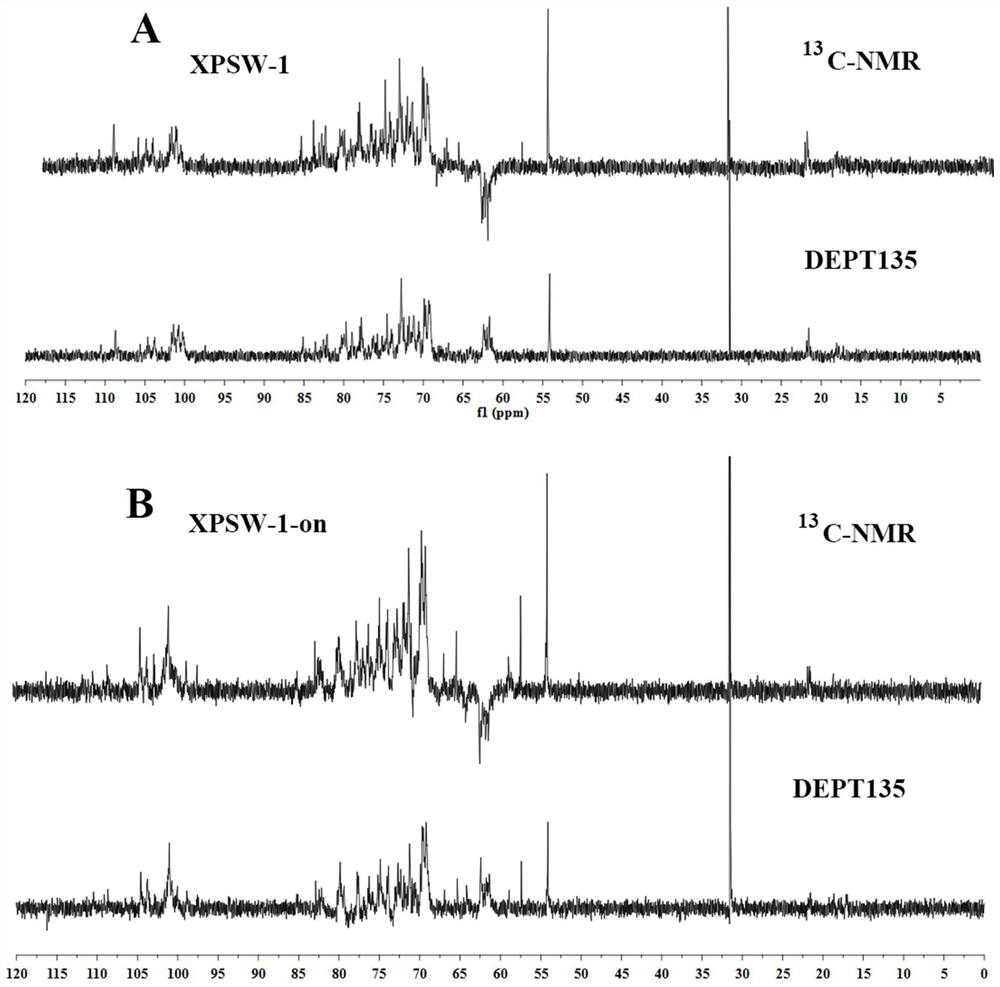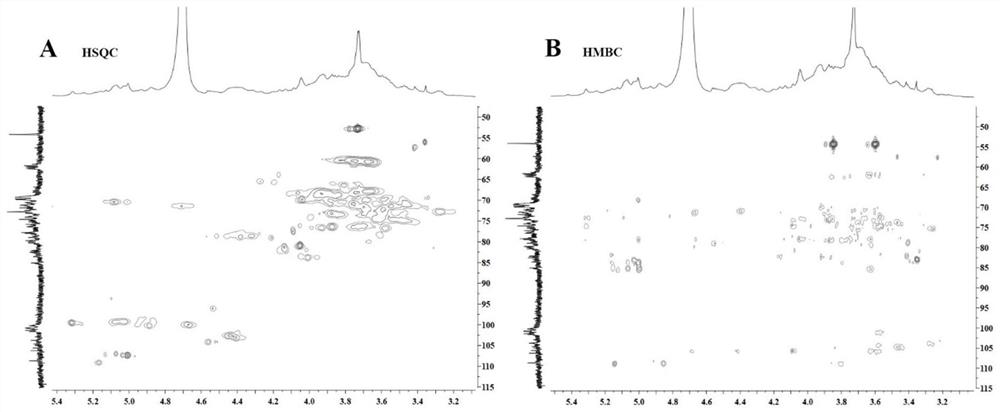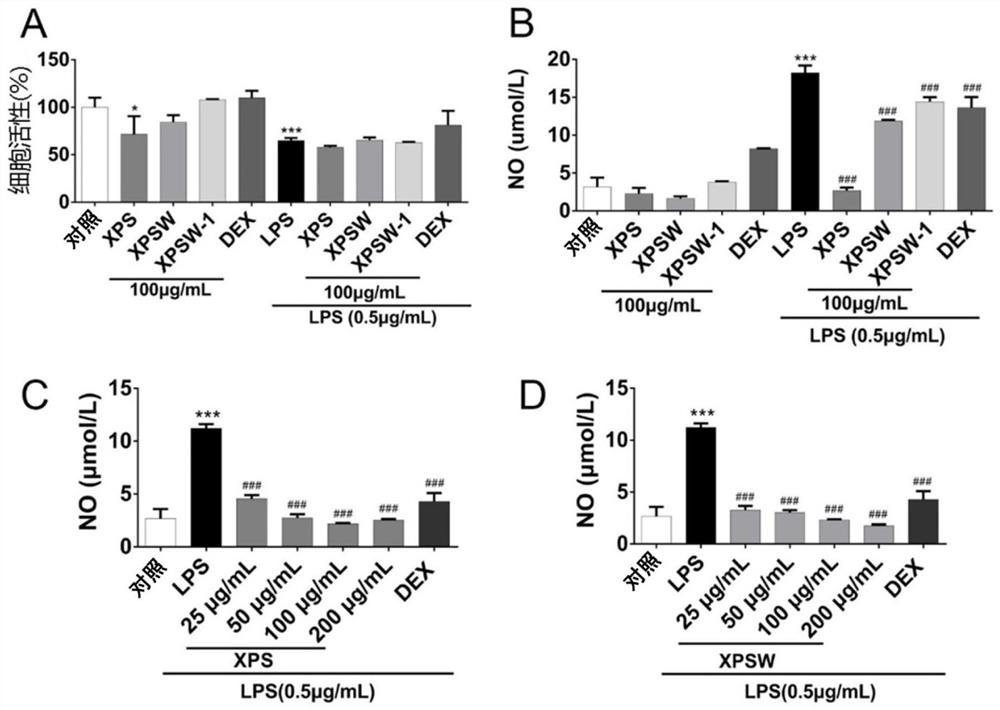Rabdosia japonica polysaccharide as well as preparation method and application thereof
A technology of polysaccharides and polysaccharides of S. japonica, which is applied in the field of biomedicine and can solve the problems of polysaccharide structure and anti-inflammation of S. basilisk.
- Summary
- Abstract
- Description
- Claims
- Application Information
AI Technical Summary
Problems solved by technology
Method used
Image
Examples
experiment Embodiment 1
[0073] Experimental example 1: Effects of crude polysaccharide (XPS), water fraction (XPSW) and homogeneous polysaccharide (XPSW-1) of Saccharomyces japonica on cell viability and NO secretion
[0074] Ana-1 cells in 2 × 10 6 Cells / ml, 100 μL / well were inoculated in 96-well cell culture plates, and the cells were cultured for 24 hours before the experiment began. The cells were divided into the following groups: normal cell control group (Control), test drug alone treatment group, endotoxin (Lipopolysaccharide, LPS) 0.5 μg / ml stimulation group, LPS (0.5 μg / mL) stimulation combined with test drug (different concentration ) treatment group, the positive drug was dexamethasone (DEX). The cells were treated with LPS and drugs for 24 hours. After culturing for 24 hours, collect 200 μL of the cell culture supernatant for subsequent experiments, then add 180 μL of 10% FBS-1640 and 20 μL of 5 mg / mL MTT to the cell wells, and after culturing for 4 hours, discard the supernatant and a...
experiment Embodiment 2
[0079] Experimental Example 2: The regulation of different concentrations of the homogeneous polysaccharide (XPSW-1) of Saccharomyces chinensis (XPSW-1) on the secretion of TNF-α and IL-6 by Ana-1 cells
[0080] Ana-1 cells in 2 × 10 6cells / mL, 100 μL / well inoculated in a 96-well plate and cultured for 24 hours for the experiment. Cells were divided into 4 groups, namely normal cell control group (Control), LPS stimulation group (0.5 μg / mL), LPS (0.5 μg / mL) stimulation combined with XPSW-1 (25, 50, 100 μg / mL) treatment group and positive drug (DEX, 20 μM) treatment group. After co-cultured at 37°C for 24 hours, the supernatant was collected for the determination of cytokines, and the levels of TNF-α and IL-6 in the supernatant were determined according to the experimental operation manual in the ELISA kit.
[0081] The experimental results showed that, compared with the LPS stimulation group alone, LPS stimulation combined with administration of different concentrations of t...
experiment Embodiment 3
[0084] Experimental example 3: Detection of the effect of the homogeneous polysaccharide (XPSW-1) of Saccharomyces japonica (XPSW-1) on the TLR4 pathway in macrophages by Western blotting
[0085] Experimental principle: Toll-like receptors (TLRs) play an important role in the immune system by recognizing specific components expressed by microbial pathogens and initiating immune responses. Among all TLRs, TLR4 specifically senses LPS, transmits signals to host cells such as macrophages, triggers signal transduction, and upregulates the expression of inflammatory cytokines, thereby causing inflammation. TLR4 activates TNF-receptor-associated factor 6 (TRAF6) through a myeloid differentiation factor 88 (MyD88)-dependent pathway. TRAF6 is involved in regulating the nuclear import level of important transcription factor NF-κB. NF-κB participates in regulating the expression levels of various inflammation-related cytokines and mediators in the inflammatory pathway. After phosphor...
PUM
 Login to View More
Login to View More Abstract
Description
Claims
Application Information
 Login to View More
Login to View More - R&D
- Intellectual Property
- Life Sciences
- Materials
- Tech Scout
- Unparalleled Data Quality
- Higher Quality Content
- 60% Fewer Hallucinations
Browse by: Latest US Patents, China's latest patents, Technical Efficacy Thesaurus, Application Domain, Technology Topic, Popular Technical Reports.
© 2025 PatSnap. All rights reserved.Legal|Privacy policy|Modern Slavery Act Transparency Statement|Sitemap|About US| Contact US: help@patsnap.com



